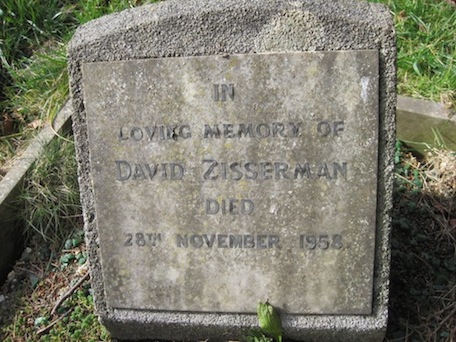David Sisserman
David Sisserman (1886 - 1958) was born in Ostrog, Volhynia, which at that time was in the Russian Empire but is now in Ukraine. He married my grandmother Raichka (Raisa) in 1916 and their only child, my father George Seymour, was born in 1917.
Some of David Sisserman’s relations were:
His father Zelig Zacharewitsch (1849-1920)
His brother, the violinist Michael Zacharewitsch (1876 - 1953)
His brother, the violinist Gregory Ivanoff (1883-1965)
His sister, the singer Sonya Chamina (1894-1996)
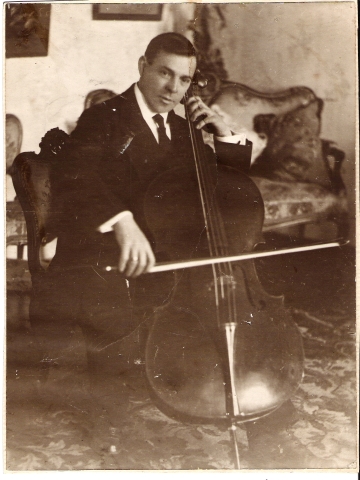
This publicity brochure was produced in 1926 in London. It summarises Sisserman’s career up to his departure from Russia in 1922:
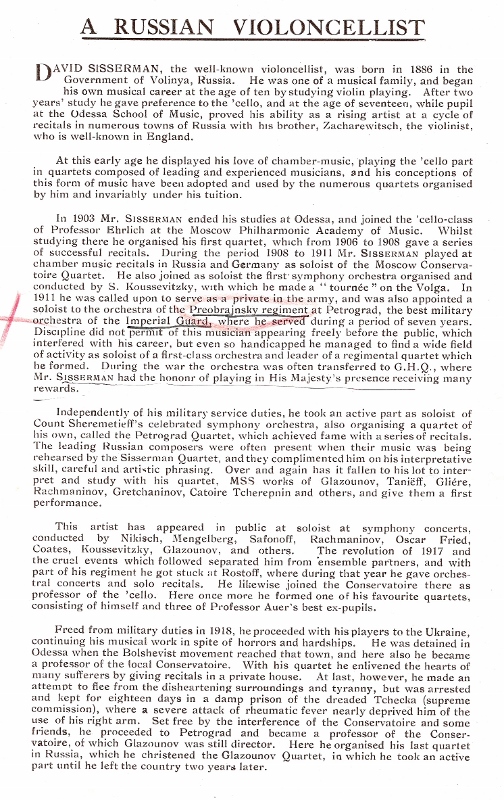
Sisserman studied at the Odessa Conservatoire until 1903, then from 1903 to 1911 at the Moscow Conservatoire. In December 1908 he was presented with this signed portrait by the conductor Arthur Nikisch:
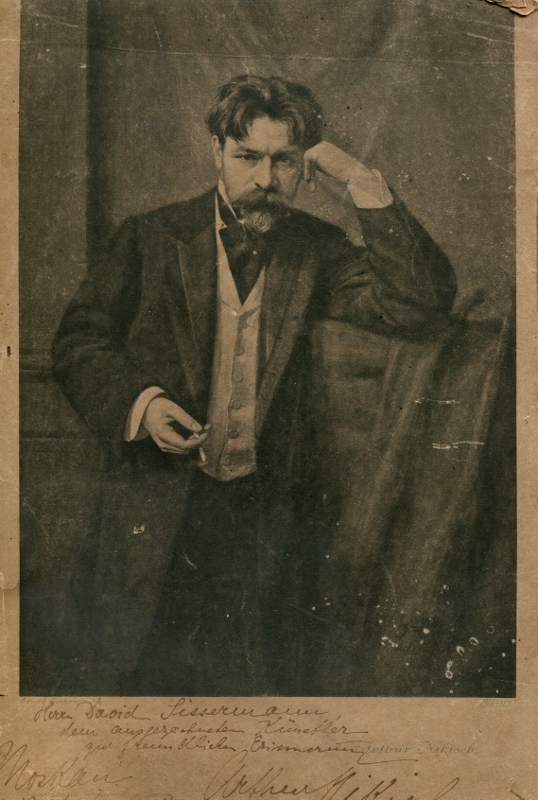
According to Raichka
In 1906, at the age of 20, David met a beautiful harpist, the daughter of a wealthy Armenian. She was 3 years older than David, and gave him all the love and attention which he had missed since his mother died [in 1904].
Her father had objected to the marriage. She was so young, so plucky to break with her family… They were married against the will of her father, who would not have a poor musician as his son-in-law.
There followed a few years of happy married life and mutual interests in music. David arranged a famous trio: violin, cello and harp – keeping happy and busy. They had been a most devoted couple but her early death had parted them. Great tragedy for David came when his beloved wife died of typhoid in Moscow [c. 1911, aged 28]. David rarely spoke to me of his late wife…
Raichka told me that for years the picture of his late wife Georgia hung over the bed she shared with David. And they named their son George.
Shortly before his departure for Petrograd, on November 10 1911, Sisserman had the distinction of taking part in a tribute concert for Tolstoy on the first anniversary of his death. Organized by Sergei Koussevitsky, the concert at the Great Hall of the Moscow Conservatoire included the Tchaikovsky Piano Trio in A Minor with Rosalia Pasternak at the piano, David Kreyn on the violin, and Sisserman on the cello. Rosalia Pasternak (mother of the author Boris) had played the same Trio in previous tribute concerts: in 1893 for Tchaikovsky himself, and in 1894 for Anton Rubinstein and the artist Nikolai Gue, which Tolstoy attended with his daughters. The Pasternaks were for many years close friends of Leo Tolstoy and his family.
The 1911 concert was recalled by Aleksander Pasternak, younger brother of Boris:
I was listening to very familiar music but I could not recognize it due to its new meaning. I had never heard such an interprnetation before. It seemed to me that it was being performed not by my mother but by someone else … I noticed Koussevitsky standing near the stage door, which was ajar. He was motionless. His head was bent in his usual pose … As a conductor, he listened to the ensemble with rapt attention … Suddenly he winced, trembled and passed his hand over his eyes, brushing away a tear.
(Ernst Zaltsberg, chapter on Rosalia Pasternak in “Great Russian Musicians”, Mosaic Press, 2002. Click here for further extracts.)
Among Sisserman’s souvenirs was this 1909 picture of Tolstoy at his Yasnaya Polyana estate:
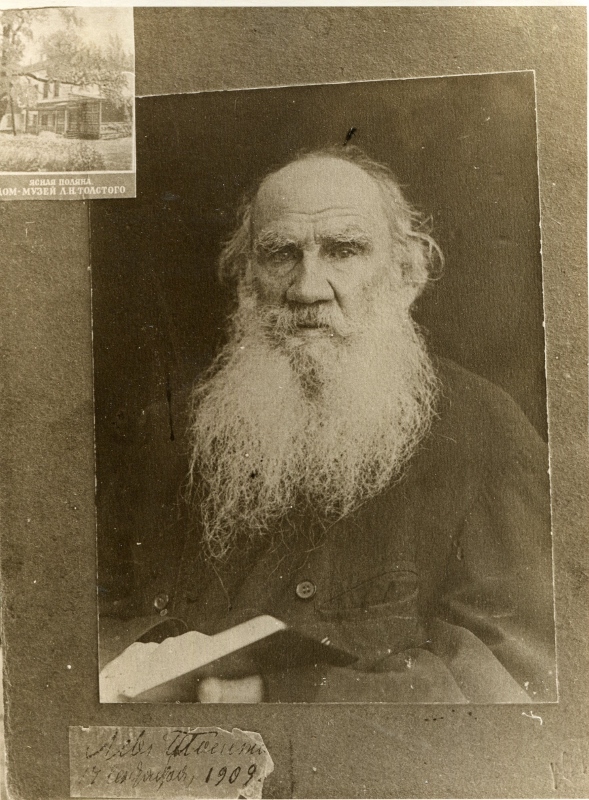
From 1911 Sisserman was in Petrograd, primarily to do military service in the Preobrajensky regiment, where his role was musician in the regimental orchestra. Insights into Sisserman’s musical life (beyond his regimental duties) at this time come from Paula Eisenstein Baker, who has for many years been working on the compositions of Leo Zeitlin, “one of the most important Russian Jewish composers to resurface, after decades of neglect, as a leading figure in the history of twentieth-century Jewish art music.“. Zeitlin and Sisserman had studied together in Odessa, and were both in Count Shermetiev’s orchestra and also the “Petrograd Quartet”. This photo of the Shermetiev quartet was taken c. 1914 and appears in the autobiography of A.B. Khessin who conducted the Shermetiev orchestra. Khessin is in the middle, Zeitlin is second from left, Sisserman on the right with cello.
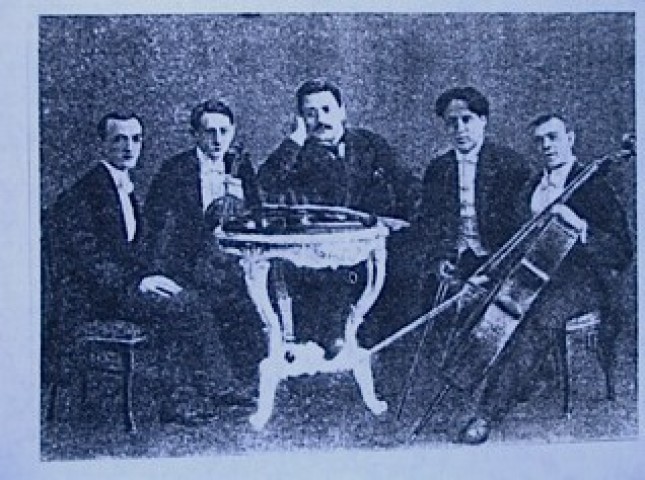
Click here to download a detailed account by Paula Eisenstein Baker about Zeitlin and Sisserman.
David Sisserman was in London in 1914: the ‘Jewish Chronicle’ reported on 31st July that he had recently played in concerts with his brother, the violinist Michael Zacharewitsch, and the pianist Adela Hamaton. According to Raichka, on the outbreak of war on 4th August David had to immediately report to the Russian Consulate and return to the Preobrajensky regiment.
After the revolution of February 1917, which forced the abdication of the Tsar, David Sisserman travelled with Raichka from Petrograd to Rostov-on-Don to join the Preobrajensky Orchestra, and apparently my father George was born the day after they reached Rostov (11 July 1917). In Rostov Sisserman was given the post of professor of ‘cello at the Conservatoire, and also formed his own quartet.
In 1918 he moved on to Odessa, where he again got a post of Professor at the Conservatoire. On his return to Petrograd he became a professor of that Conservatoire, of which Glazounov was still director, and his last quartet in Russia was called the Glazounov Quartet.
The pianist Claus-Christian Schuster, who is (August 2013) working on piano trio history, has sent me this information: “Last time I played in St Petersburg, I found a programme dated August 6th, 1921, under the title of ‘Grand concert for the benefit of the starving population of the Volga Region’. David Zisserman was joined there by pianist Nadežda Golubovskaya (1891-1975) and violinist Il´ya Lukaševskij (1892-1967) in a performance of the Čajkovskij-Trio.”
England 1923 - 1929
According to Raichka, she and David planned to emigrate to England as early as when they married in 1916, but after the Revolution emigration was not permitted by the Bolsheviks. Their future was suddenly and dramatically changed when the Polish-Soviet War ended and the treaty known as the Peace of Riga (March 1921) ceded to Poland the western part of Volhynia. As a result, David Sisserman was reclassified as a Polish citizen, he had to obtain a Polish passport and was actually required to leave Russia.
The family stayed for some months in Germany: David was giving concerts in Berlin in 1923 (information from John Spritz). Probably they were waiting for English visas to be arranged by Sisserman’s brother Michael Zacharewitsch. It may be significant that Michael’s British naturalisation was being processed in July 1923 and on 1st September 1923 David, Raissa and George arrived in London.
In September 1924 David Sisserman, aged 38, was one of five “bandsmen” on a ship, the Orduna, which made a return journey between England and New York. From 1924 for at least two years, David Sisserman was the chief professor of Violincello and Chamber Music at the Middlesex College of Music, Uxbridge. In April 1926 A. Adela Hamaton, Principal of the college, wrote that Sisserman “has proved himself to be a most talented artist and teacher. He also teaches and conducts the College Orchestra, and is undoubtedly most popular with all his students. His work is of the very highest standard and I … am only too pleased to be able to speak of him in terms of praise, not only for his enthusiasm in his work, but for the excellent results he obtains.” (A. Adela Hamaton was a pianist who taught David’s nephew, Joseph Saxby.)
Click here to download details from concert programmes 1924 to 1928.
On 2nd October 1925 this appeared in the Jewish Chronicle: “Mr David Sisserman and Miss Agnes Mill gave an interesting ‘cello and pianoforte sonata recital at the Wigmore Hall on Wednesday night, the programme of which included Beethoven’s A major sonata, Debussy’s D minor sonata, and Rubinstein’s D major sonata. Even in the simplest work, the ‘cello is an instrument which, when heard solo, must be perfectly played. The slightest error of tone or phrasing is peculiarly emphasised in this instrument. This recital was a particularly severe test for a ‘cellist, and Mr Sisserman came through with flying colours, especially in the Serenade and Finale of the Debussy sonata, which requires a great deal more than mere technique.”
This is the programme for Sisserman’s concert at the Wigmore Hall on 28th June 1926:
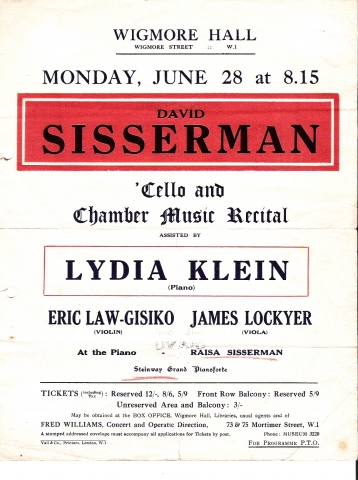
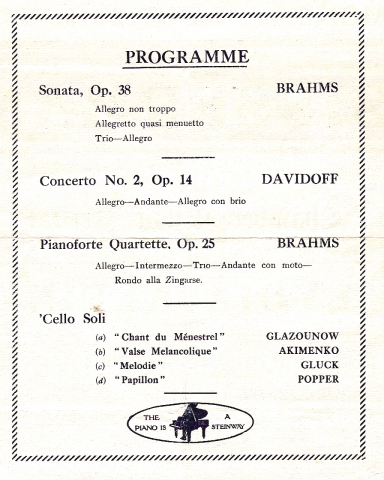
The Daily Telegraph wrote that “Sisserman at the Wigmore Hall last evening played with a great deal of dash and assurance” and the Jewish Chronicle that he “played … with brilliance, finish and surety.”
The publicity document “SISSERMAN, Violincellist”, London (1926) was produced at the time of this Wigmore Hall concert, and contains tributes to him from Nikisch, Glazounov, Albert Coates, and Kousssevitsky. Click here to download extracts from this publicity document.
From July 1926 to 1928, and again (on his return from Australia) from 1931 to 1932 programme listings in The Times show that Sisserman was regularly broadcasting on BBC Radio, presumably under contract.
Tour with Pavlova, and first stay in Australia 1929 - 1930
Anna Matveyevna Pavlovna Pavlova was born in St. Petersburg in 1881. She studied at the Imperial Theatre School, St. Petersburg, graduating in 1899 as coryphée and within seven years (1906) was promoted to prima ballerina. She performed in the opening season of Diaghilev’s Ballet Russe in Paris in 1909 and by 1911 formed her own dance company with which she toured all the continents until her death in 1931.
Pavlova made Australian tours in 1926 and 1929. The Australian National Library holdings of theatre programmes reveal that in her 1926 tour “Pavlova presented eighteen ballets… She also staged a staggering fifty-five divertissements - short pieces showing off a particular ballet technique, including her signature piece The Swan. Due to their popularity Pavlova repeated most of the ballets and approximately half of the divertissements throughout her second tour.”
David Sisserman was part of the second tour in 1929 which travelled to Brisbane, followed by Sydney, Melbourne, Adelaide and Perth. Pavlova “presented approximately thirteen ballets and thirty-eight divertissements. On this return tour she was partnered by Vladimiroff and other members of her company included Edouard Borovansky with Algeranoff making another visit. According to the programmes the company consisted of 42 dancers, however Australian extras would have increased this number.”
When I was a child, I was always told that David Sisserman played Pavlova’s “signature piece”, The Dying Swan by Saint-Saëns from Carnival of the Animals. When I visited Melbourne in September 2013 I was assured that Anna Pavlova had insisted on having Sisserman as her cellist for the 1929 tour. And Samuel Wynn has this to say in his autobiography (“The Fortunes of Samuel Wynn”, Cassell, Melbourrne, 1968, pp 128-9): “Sundays at the Newmarks’ were mainly for music. Practically every musician of importance in Melbourne played there, but the regulars [included] David Sisserman, a great ‘cellist … Sisserman was one of the most beguiling members of the group. He had been Pavlova’s ‘cellist, and it was said that she would not dance her Dying Swan unless he played for her.”
This photo shows Sisserman (far right) with Pavlova (centre, showing her leg) in Egypt.
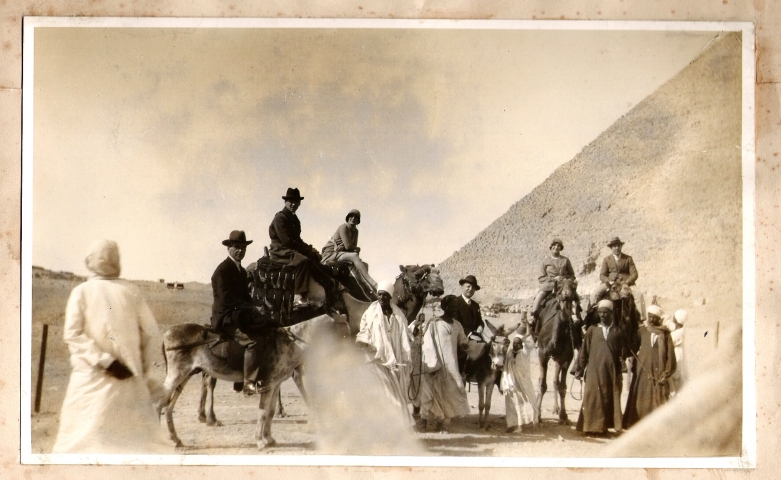
Arrival in Australia, Sisserman (with the cello) next to Pavlova.
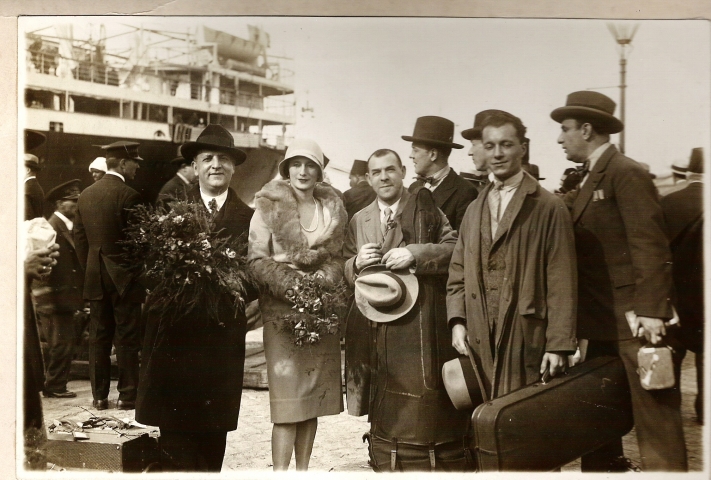
From Pavlova to Sisserman, dated 1929.
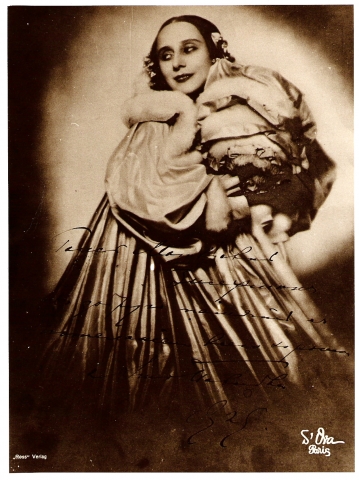
On 12th May 1929 the Sunday Times of Sydney included these items in its Radio Programmes listings: “From the Palace Theatre: a concert arranged by the N.S.W. Broadcasting Company, Ltd., in conjunction with the United Charities Fund. The Mozart Trio (from the Pavlova Orchestra): “Trio in D Minor” … Peter Bornstein (violinist), David Sisserman (‘cellist), A. Rachmanoff (pianist)“. And also “‘Cello solos by Mr David Sisserman: ‘Elegie’, (Op 27), ‘Waltz’ (Mequette), and ‘Guitarre’“.
On 10th July 1929 the Daily News of Perth reported: “Many will be glad to hear that David Sisserman, the ‘cellist, will not return to Europe when Pavlova and her company leave Australia next month (says the Melbourne ‘Herald’). This musician has been a solo performer with orchestras under many of the leading Continental conductors, and he will play a concerto with the Melbourne Symphony Orchestra in August. It is interesting to note that Mr. Fritz Hart has arranged for his joining the teaching staff of the Albert-street Conservatorium. Sisserman is a brother of Zacharewitsch, the violinist who toured Australia a few years ago. He is also a brother of Gregory Ivanoff, the violinist who was formerly on the staff of the University Conservatorium. These two will meet here for the first time in 15 years.”
On 16th July 1929 the Daily News of Perth published a fuller piece under the caption: “Pavlova’s ‘cellist. Artist from Russia. Mr. David Sisserman.” “Among the gifted musicians who form the orchestra that is contributing so materially to the success of the Pavlova dancing season is a particularly noticeable personality in David Sisserman, the ‘cellist … A Russian by birth, he was a professor at the Petrograd Conservatorium, and, like many another talented musician of his country, he found the Revolution and its tragic aftermath so inimical to the practice of his art that he was obliged to leave Russia and seek a more sympathetic atmosphere. ‘The Soviet’, he explains, ‘say that your art, like all else, belongs to the community, and you must, therefore, give it gladly, whether you are paid or not. So the artist, he feels no breath, no inspiration; it is as if a sword hangs over his head while he sings or plays. There are still many great artists in Russia, but they must live as they can; for their art there is little hope.’ ….. Recalling his playing and teaching at Petrograd before the Soviet made it a ‘starvation job’, Mr. Sisserman mentioned that he had been closely associated with Glazounoff, Russia’s modern master musician, whose compositions figure prominently in the Pavlova programmes… So experienced an exponent of the ‘cello should prove an acquisition indeed to the Albert-street Conservatorium , which has done so much to foster the practice and appreciation of music in Australia.”
One of Sisserman’s concerts in the latter part of 1929 was on 19th October at the Melbourne Town Hall, supporting “Nancy Weir, the brilliant child pianist” (advert in Melbourne Argus on 18th October). Nancy Weir was just 14 at this time, and this was a benefit concert to raise funds for her to pursue her musical studies in Europe. A review of the concert (The Mercury, Hobart, 21st October) said that “Sisserman, who came here with Pavlova, was at first a little nervous, and his beautiful tone did not reach all corners, but as he warmed up to his work he and Lindsay Biggins, the accompanist, worked in a delicious unison to give us the ‘Glieres Ballade’, ‘Debussy Minuet’, and ‘Popper’s Eifentanz’. As an encore he added a choice morsel from Gluck and quite made up for any disappointment we felt over the rather uneven first number …. Rubinstein’s Sonata in D Major for piano and violin, first movement only.”
On 22nd November 1929 the Melbourne Argus reported: “A new organisation, the Sisserman String Quartet, gave a concert last night in the Assembly Hall before an audience which made up in enthusiasm what it lacked in numbers. Under Utopian conditions music-lovers in every great city would have regular and frequent opportunities for hearing such things as the symphonies of Beethoven, the organ music of Bach, the motets and madrigals of the Tudor period, and the masterpieces of chamber music. Melbourne has for some time been well served in every department of musical activity save the lastnamed: in the realm of chamber music there has recently been a period of something like stagnation, and it is a matter for congratulation that this new string quartet has appeared on the horizon. Mr. David Sisserman, the ‘cellist, has three talented collaborators in Messrs. Gregory Ivanoff, Reginald Bradley, and Mischa Kogan. They bring to their work an extensive technique together with an exuberant intensity: dullness is never allowed to supervene, indeed it might perhaps be suggested that the Sisserman quartet would make a greater effect if it lessened the number of irs ‘effects’.” Music played included a Beethoven Quartet, a Trio by Albert Dupuis, and quartets by Arensky and Borodin. “The Arensky came near to carrying on the tradition of super-effectiveness which had been established by the [Dupuis] Trio: plenty of cleverness went to the playing: a less demonstrative style would perhaps have been welcome. The Borodin example approached rather more closely to what might be called the norm in chamber music.”
On 9th January 1930 The Mercury, Hobart, wrote: “There is no more beautiful form of chamber music than that of the string quartet, in which the greatest masters have poured out their inspiration. Unhappily the music-lovers of Hobart, although relatively well provided with some forms of good music … have for many years had no opportunity of listening to a fine string quartet. It is therefore welcome news to learn from an interview in ‘The Illustrated Tasmanian Mail’ that David Sisserman, the Russian ‘cellist, of the teaching staff at the Albert Street Conservatorium, Melbourne, has set himself the task of building up a good quartet. With his brother, Gregory Ivanoff, as first fiddle, Reginald Bradley, from South Australia, as second, and Mischa Kogan, a Russian, as viola-player, he has made up his mind to bring the new quartet ‘up to the highest pitch of efficiency’. He has already thought of Tasmania as suitable for a tour. ‘I hope’, he says, ‘to go to Tasmania, certainly; but for the moment I have no plans. It is for those who want me to suggest them.‘”
On 20th June 1930 the Melbourne Argus wrote: “A pleasing variety characterised the items played by the Sisserman Quartet at the chamber concert last night in the Assembly Hall before an appreciative audience. A Mendelssohn quartet (op.44 no.2) , played with almost unexpected vividness, led into Beethoven’s Sonata in A Major (op 69) for ‘cello and piano. The sonata was finely played by David Sisserman and Raymond Lambert. Those artists were joined by Mr. Reginald Bradley in Tschaikowsky’s Trio (op. 50) for piano, violin, and ‘cello, a work which gives scope for a quasi-orchestral style of playing. Alfred Hill’s second quartet has a detailed ‘programme’ based on incidents in the life of the Maori; owning to the lateness of the hour (this quartet came at the end of the programme) only two movements could be given; these proved so interesting that it may be hoped that the whole work may be played later…. The work of the Sisserman Quartet shows every sign of being a labour of love, and musical people may well recognize an obligation to support such a source of chamber music of the finest type.”
On 5th July 1930 the Evening Post (Welington) reported - somewhat belatedly: “A new string quartet has come into being in Melbourne, where David Sisserman, formerly of Pavlova’s orchestra, has settled. He has associated himself with three Melbourne musicians, and the quartet is called The Sisserman String Quartet. The other players are Reginald Bradley, Rene Brogozzo, and Mischa Kogan, and the party intends giving chamber music recitals. The first violin, Mr. Bradley, is well known on the radio, and was conductor and director of programmes at 3LO, Melbourne, when wireless was a novelty.”
On 6th August 1930 Sisserman obtained British citizenship while a resident of Australia. The certificate notes that he was “hitherto a Polish citizen” (since 1921), and “has formally renounced his allegiance to the Republic of Poland.” His address was Exhibition Street, Melbourne.
On 4th September 1930 the Melbourne Argus noted that Sisserman would be giving a concert on 16th September at the Assembly Hall, before his departure for Europe.
Return to England 1930
David Sisserman appears on the passenger list of a boat arriving in Plymouth from Fremantle (Perth) on 31st October 1930. He is “Prof. of Music” aged 43, place of permanent residence Australia and next place of permanent residence England. His address is 10 St. Andrews Road, Golders Green (which was George’s address in 1935). Both David and Raissa Sisserman appear on the electoral register at this address in 1931. But in the 1932 electoral register they were both listed at 124 Inverness Terrace W 2 (Bayswater).
On 1st December 1931 Sisserman (with Doris Hibbert, piano) played at a concert at George’s School - St. Marylebone Grammar School. Music by Rachmaninoff, Tschaikovsky, Beethoven, D. Popper, C. Chaminade, and Glazounov.
In November 1932 this appeared in the Jewish Chronicle: “PROVINCIAL JEWRY will have the opportunity of hearing Yiddish Folk-songs, specially composed for the celebrated Yiddish Folk-song singer, Marie Rapjanowskaja, known as the “Woman Caruso”. She will be assisted by Professor David Sisserman, with a vocal and instrumental quartet. She will appear in Leeds on Monday evening next, at the Town Hall; on Thursday, the 10th inst., at the Picton Hall, Liverpool; and on Saturday evening, the 12th inst., at the Albert Hall Manchester.”
In December 1932, The Times announced: “Pianoforte trios by Mozart and Beethoven (Op. 97) will be played by Messrs Zacharewitsch Sisserman and Creith at the Royal College of Nursing, Henrietta Street, W1.”
Second period in Australia from 1933
Sisserman returned to Australia in March 1933. His arrival was recorded in the Melbourne Argus: “For the purpose of reorganising the Sisserman String Quartet for the Melbourne Chamber Music Club, Mr D Sisserman, ‘cellist, returned to Melbourne yesterday by the P. and O. liner Strathnaver. Since he was in Australia two years ago Mr Sisserman has been in London where he was associated with the British Broadcasting Corporation.” On 6th March the Adelaide Advertiser reported: “FAMOUS ‘CELLIST RETURNS. Mr David Sisserman On Way To Melbourne. After an absence of three years, Mr David Sisserman, the celebrated ‘cellist and former professor of the Melbourne Conservatorium, returned from abroad on Saturday on the Strathnaver. While in London Mr Sisserman gave several series of chamber recitals. In one of them he was accompanied by Dr Malcolm Sargent, one of England’s leading conductors. Later, Mr Sisserman was invited to play as leading solo ‘cellist in the famous London Symphony Orchestra…. Mr Sisserman was met in Adelaide by his brother Gregory Ivanoff. Before settling down in Melbourne, he proposes to give chamber music recitals throughout Australia and New Zealand…. Mr Sisserman accompanied Pavlova on her 1928 tour of the East and Australia, and while he held his position in Melbourne, with which he combined the post of leading soloist of the Melbourne Symphony Orchestra, he established the Sisserman String Quartet, whose performances earned it a high place in Melbourne musical circles.”
The National Library of Australia has catalogued concert programmes and related material for the Sisserman String Quartet.
There also exists an advertisement for a concert on 4th November 1933: “Four Brisbane Recitals of England’s geatest singer DAME CLARA BUTT …… Assisting Dame Clara Butt will be the AMATI INSTRUMENTAL TRIO (Piano, Violin, and Violincello), and the brilliant International Solo Artists:- DAVID SISSERMAN, Celebrated Russian ‘Cellist; RAYMOND LAMBERT, distinguished Belgian Pianist; and PHILLIP COHEN, young Australian Genius of the Violin.”
(Incidentally, Michael Zacharewitsch had performed with Clara Butt in Liverpool in 1905-1906.)
The Courier-Mail newspaper (Brisbane) wrote that “Dame Clara Butt, whose Brisbane season will be opened in the City Hall to-night, is an exception to the idea that artists must suffer adversity before they win fame. Few on the stage or the concert platform can look back to such encouragement as she received. The public esteem for her has never wavered…. Many songs have been specially written for her by various composers. The visit of David Sisserman with Dame Clara Butt’s party recalls two notable trios of brothers. One is comprised of Slsserman, Zacharavltsch. and Gregory Ivanoff; the other of the Spivakovskys. By a series of coincidences, four of the six are in Australia at present.” This newspaper also says: “Two well-known radio artists, David Sisserman (Russian ‘cellist) and Philip Cohen (a brilliant young Victorian violinist) … were two of a combination engaged some time ago by the Australian Broadcasting Commision, which recognised their very fine musical achievements. In the Russian province of Volynia, where David Sisserman was born, his family was noted for its musical achievements. His brother, Zacharewitsch, played in England and another brother, Gregory Ivanoff, is well known in Brisbane. At the age of 17 years David Sisserrman was a pupil at the Odessa School of Music, and proved his talent as a ‘cellist throughout Russia. He was also a soloist in the Moscow Conservatorium Quartet.”
One of the members of the Sisserman String Quartet was William Lamble. The obituary of Lamble’s son, the actor Lloyd Lamble (1914-2008) says that “Lloyd Lamble was born in Melbourne. His father, William H.S. Lamble … was a viola player with the Melbourne Symphony Orchestras and the Sisserman String Quartet. His grandfather was a professor of music.”
Sisserman appears on the Electoral Roll for Melbourne in 1936. The Australian National Archives has a collection of papers about Sisserman covering 1936-1947, lodged by the Australian Broadcasting Commission (ABC). On 30th December 1936 he wrote a letter from his address at 48 Drummond St, Carlton (a district in Melbourne near the Music Conservatorium) to Mr James, the Federal Controller of Music for the ABC. He asked to be considered for appointment to the Melbourne String Quartet as cellist for broadcast purposes; and for an audition as a conductor for “special Russian and light symphony pieces”. In January 1937 Mr James replied that there was no direction from the committee to reconstitute the existing Melbourne String Quartet; and that there was no vacancy for a conductor.
Tour with Trio to New Zealand and England, 1938
On 9th December 1937 the Melbourne Argus reported: “SISSERMAN TRIO. The Sisserman Trio, comprising Messrs. David Sisserman, Henri Penn, and Philip Cohen, will leave Melbourne in January [1938] for England. They will visit Sydney and New Zealand, and will return from England by way of South Africa. They will broadcast in the principal cities visited.” (link) On 20th January 1938 the same paper reported: “M. Henri Penn, pianist, left Melbourne by the Kanimbla last night for Sydney, where he will join Mr. Philip Cohen, violinist, and Mr. David Sisserman, ‘cellist, on a 10 months’ tour of the United States, Britain, and South Africa. While abroad the trio expects to undertake broadcasting work. They will study methods of musical education for the Education Department.” (link)
This appeared in The Auckland Star column OVER THE AERIAL: RADIO NOTES: “The next overseas artists to make a tour of the National stations are three celebrated instrumentalists, Henri Penn (pianist), Philip Cohen (violinist) and David Sisserman (‘cellist). The three open as a trio at 2YA on February 7. Henri Penn was for several years a professor at the Conservatorium of Music, Sydney, and also at the University Conservatorium at Melbourne. He has played under such interesting personalities as Saint Saens, Richard Straus and Beecham, while he also played for Miss Schumann, a granddaughter of the composer. Philip Cohen is an Australian violinist who has had a colourful career, and David Sisserman is an international ‘cellist: he is at present the leading ‘cellist for the A.B.C.’s [Australian Broadcasting Commission’s] Melbourne Orchestra and the Melbourne Symphony Orchestra.” The studio recital was indeed broadcast on February 7 from 2YA, Wellington (Evening Post). In another broadcast 3 days later, the Zigeuner Trio performed works included ‘cello solos ““Malaguena” (Ravel), Scherzo (Goens), and Minuet (Boccherini) - also reported in Evening Post. Further recitals by the trio were broadcast on February 10th and 23rd and March 4th.
On 9th March 1938 an advert in The Evening Post read: “NIMMO’S CONCERT HALL, TONIGHT at 8.15 o’clock. The last opportunity to hear THE ZIGEUNER TRIO. Prior to departure on World Tour.” So by this time the trio’s name had changed from the Sisserman Trio and Henri Penn was listed first.
David Sisserman, aged 51, arrived in England on 14 April 1938 aboard the MS Rangitiki from Australia. He is listed as “Professor of Music” and his London address as 36 Leinster Gardens, W 2 (Bayswater) - which is very close to Inverness Terrace where David and Raissa were on the electoral register in 1932. In 1938 both David and Raissa were listed at 36 Leinster Gardens in the electoral register.
The trio performed at a concert in London in June 1938 as the Zigeuner [“Gypsy”] Trio. The Australian archives holds a programme for “a concert held at the Anglo-Palestinian Club in London at 8.30pm on Sunday 12 June 1938. The concert featured the Zigeuner Trio on a visit from Australia and soprano Miss Lola Shari. Members of the Zigeuner Trio were pianist Henri Penn, violinist Phillip Hillier and cellist David Sisserman.” (link)
Return to Australia 1938
Sisserman returned to Australia without completing the planned 10 months’ tour of 1938: he departed from Southampton on 30 July 1938 abroad the Jervis Bay bound for Sydney. Sisserman had a two-berth cabin, and when he encountered a young George Brodsky invited him to share his cabin. The Brodskys had been a prominent family in pre-revolutionary Ukraine, and as noted philanthropists had apparently contributed to Sisserman’s musical education (Alexandra Fanny Brodsky, “Smoke Signals: From Eminence to Exile”, p.171). George Brodsky would become an eminent linguist, lawyer and writer in Sydney.
While on board the Jervis Bay, on 31st July 1938 Sisserman wrote a letter to the ABC, informing them that the boat would land in Fremantle and asking them to arrange a tour of Perth - Adelaide - Melbourne - Sydney before he would resume his duties with the orchestra in Melbourne. On 24 August 1938 the ABC sent a letter in reply, turning down the suggestion of a tour but confirming that “your place in the Melbourne orchestra is available for you as soon as you arrive back in Victoria”. During November 1938 Sisserman wrote further letters to the ABC from his Studio address in Russell St, Melbourne. He asked for solo appearances with the orchestra and a tour of the ABC circuit; help with the formation of “a first class String Quartet”; and repeated his earlier idea about conducting Russian and light music. Various officials at the ABC concurred in dismissing all these ideas, and this was communicated to Sisserman in a letter from Mr James on 18th November. On 7th December 1938 Sisserman wrote yet another letter to the ABC pressing the same suggestions, and on 12th December Mr James politely replied again in the negative.
Illness and Institutionalisation in Australia 1939 to 1947
The collection of papers about Sisserman in the Australian National Archives, lodged by the Australian Broadcasting Commission (ABC) is titled for the period 1936-1947, but there are no documents for the period between December 1938 and August 1947. In 1939 he suffered a period of depression, and two years later, in November 1941, following assessment at Park Royal hospital in Melbourne, he was admitted to Mont Park hospital, also in Melbourne. In April 1943 he moved to Hillcrest, a private nursing home in South Melbourne, but returned for assessment at Park Royal in April 1944 and was re-admitted to Mont Park later that year. In December 1944 he was transferred to the psychiatric hospital in Ararat.
In a letter to Mr James of the ABC dated 18th August 1947, Sisserman wrote from Ararat Rest House, Ararat, Victoria. “I had a marvellous escape from heartbreaking conditions which Melbourne [?unreadable], due to the war conditions, and spent from 194- [sic] till now in a far remote country at a resting [home] … And now I am culminating my time of residing at this blessed institution, and only am in need of a home - house for me to settle, and as I have to expect my family to arrive in due course from England.” Though now aged 61, and having spent the past six years in psychiatric institutions, Sisserman wrote that he planned “to make a fresh start” and that he was free to leave the rest home “as soon as accommodation is available”.
On 25th August 1947 Mr James replied: “It is so pleasing to know that you personally are feeling so much better and are on the road to complete restoration of health”.
On 28th August 1947 Sisserman wrote again to Mr James. “I never been better in my physical condition, than at the time I was admitted to this institution 6 years ago, but the general conditions of the world, and the effect on my beloved art, in Melbourne, when my quartet was disbanded, due to Mr Philip Cohen’s desire to remain in England, and I began to lose vitality and inspiration for any high standard exploits, neither with my quartet nor with the Melbourne Symphony Orchestra.” In order to re-launch his career he was anxious to retrieve his collection of critics’ reviews which he had left with a friend. “The name and address where my book is kept: Mr P. Lasica, 52-56 St Francis Street, Melbourne (Manufact. of Men’s Select Rain and Sports Wear). He is in the week days available and a letter to him will summon this book. Please cut out my authorised slip which must reach him.” This slip reads: “Dear Mr Lasica! Please kindly handle [sic] my book with the critics and the documents which I sent to you long time ago without any doubt that it is on my request for the Austr. Broadcasting Commission to obtain. Yours sincerely, David Sisserman. 28.8.1947. Ararat Rest House.”
On 19th September 1947 Mr James wrote that all positions in the Sydney Orchestra were filled, and the same day Sisserman wrote another letter to him. “I just got an air-mail letter from my family, whom I expected to come to Australia …. But from the letter which was posted on the 6th of September I learned that due to my son George D. (professionally) Seymour, who was on special services to the Military Government of British Zone in Berlin … has to take a new job in London, with family - Nora and grandsons, and my dear wife who will look after the boys and is angering for me to reach England”. He therefore appealed to Mr James for help arranging a tour including passage to England.
On 7th October 1947 Mr James replied that he was unable to help with such a tour but added: “I am glad to know you are feeling fit again, and sincerely hope that you will be able to join your wife and family in the near future.”
On 14th November 1947 Sisserman wrote a letter to his sister Sonya and brother-in-law Mischa in New York: “Ararat Rest Home is at present the ideal place to be, and soon I hear from my family of the time when they arrive, my freedom from this heavenly (under circumstances) place.” (This in spite of the fact that on 19th September he had received the letter that George and family would not, in fact, be coming to Australia.) Sisserman also followed up the request he had sent to Mr James on 28th August, to retrieve his collection of critics’ reviews. “The name of my admirer is … Mr Lasica, 52-56 St Francis Street, Melbourne, Victoria. I’ve already written to this friend, but unfortunately can not completely trust him so will write to you if he does not satisfy my demands.” Sisserman refers in this letter to “our possible united enterprise” in which Mischa would become his manager. After obtaining the brochure from Mr Lasica he requests that it be printed and sent out “with a letter from Mischa as my manager” to a list of musical connections including “Mr Sergey Koussevitsky (Boston Symphony Orchestra) …… All they are my nearest friends and past members of my Sisserman String Quartet….” which he plans to re-establish, possibly in the USA.
Final year in Australia 1948
In January 1948 Sisserman was transferred from Ararat to the private nursing home Hillcrest, in Melbourne. On 2nd February 1948 Mr C. Charlton wrote this inter-office memorandum to Mr W.G. James: “Following an interview with Mr Sisserman, we arranged that he play with us in order to insure ourselves that his standard of work was satisfactory to our requirements. Confidentially, I have spoken to the Medical Officer in charge of this man and he assures me that mentally he is quite sound but that he is still very excitable. He also feels that if Sisserman is unable to get back, in some way, to the world of music, it may set him back and make him a serious mental patient. When he played to our Committee, he revealed that he has lost little facility technically, although he naturally still plays with a very emotional style, full of glissando. We feel that, considering all circumstances, we could give him a trial in a solo recital, but, frankly, we are not prepared to consider him for the Orchestra at the moment, as his excitability would be a factor against him when in conjunction with other players.”
W.G James replied to this memo on 5th February 1948: “I am interested to read your report on the condition of Sisserman’s health and mental state. I have no objection to your giving him a trial broadcast in a solo recital, but must stress that the onus is on you to decide whether he can undertake this reasonably satisfactorily. Regarding orchestral work; I am in accord with your opinion.”
On 25th February 1948 Sisserman’s brother Gregory Ivanoff wrote to their sister Sonya from his home in Sydney: “Regarding David - he was lately writing most rational letters he ever did in his life. And the doctor gave him permission to recommence his life work in Melbourne. I thought that it was a triumph of medical science when I saw the doctors report to me… “ But a few weeks after his discharge from Ararat Gregory had not heard anything about David’s readjustment to life. Gregory believed that George and family “are coming soon to Australia: - I have great hopes on their final influence on David’s future for good!”
Sisserman’s solo broadcast in April 1948 was a concert for C.E.M.A., the New South Wales based Council for the Encouragement of Music and the Arts, formed in 1943 and later called the Arts Council of Australia. It was not a success with the ABC. In a memo dated 6th April 1948 Mr V.G. Williams, Music Supervisor at the ABC wrote: “I feel this man is going to be a problem. When he played for an audition at the Commission some weeks ago there was something of his old artistry, but in this lunchtime recital he revealed nothing whatever except a harsh inartistic tone and quite a few false intonations. His playing was rough and musically unstable. He appears to be incapable of controlling his emotions.”
In response to this memo, on 13th April 1948 W.G. James wrote to C. Charlton: “I feel that this player should not be given further engagements until you are quite sure that you can depend on him to give a good performance.” To this memo Mr Charlton - evidently a man of great humanity - replied on 22nd April: “While we agree that an artist who is not up to standard must not appear on the air, we feel that this particular case needs careful handling in view of the long period of treatment through which Mr Sisserman has gone. It is true that he is unstable and has moments of extreme excitement. We therefore suggest that, if you are agreeable, we arrange a further programme at some suitable time and record it without the artist’s knowledge. This recording could then be forwarded to you and you could judge for yourself first hand.” On 26th April W.G. James replied: “There would be no point in making a record of Mr. Sisserman’s playing and forwarding it to this office, seeing that the standard of his work is apparently variable and that in the last resort it is you who must accept the responsibility for putting him on the air. I agree that the case will need careful handling and would have no objection to your giving this artist a further programme providing (as already stated) you make sure that you can depend on him to do good work.”
In contrast with the criticism by the ABC of Sisserman’s concert for C.E.M.A., other reviews in April 1948 were exceptionally good - especially considering his recent experience of some six years in mental institutions. One (unattributed) press notice has this to say: “It is not often, these days, that one can call a local musician ‘artist’ without any qualifications, but one has no hesitation in using that term for David Sisserman, heard again in Melbourne’s Assembly Hall after an absence of seven years. The occasion was a C.E.M.A lunch-hour concert featuring Mr. Sisserman and the pianist Henri Portnoj. Mr. Sisserman’s control and understanding of his instrument is remarkable. One almost expects it to get up and walk, so clearly can it speak in nuances of almost every possible degree. Not only is the cellist’s technique very highly developed, but his interpretations bear the impress of a highly original mind which is not afraid to create effects of its own imagining.” The reviewer comments that early in the recital, playing 16th century pieces “the player’s attention seemed to wander at times from his intonation, but this inconsistency was soon stabilised. The Adagio from Bach’s Toccata in C Major was made too over-ecstatic and emotional for my liking, but the Intermezzo of Grandos was delivered with an unforgettable sense of its magic”.
On 26th April 1948 the “Bendigo Advertiser” published a review entitled “MASTERLY RECITAL AT BENDIGO: A violincello recital is a rarity in musical circles, and the committee of the Music Lovers’ Club gave members on Saturday night an opportunity of hearing this sonorous instrument handled superbly by such a fine exponent as Professor David Sisserman, of Melbourne. From a wide range of compositions, including works by Bach, Tschaikowsky, Schubert, Scriabine, Grandos, Moszkowski and Covals, the whole gamut of the emotions were traversed by the audience, as David Sisserman led them by his artistry through moods grave, gay, whimsical, thoughtful and soul-stirring.”
On 30th April 1948 the “Melbourne Sun” published a review under the caption “David Sisserman Again Brilliant”: “The well-known ‘cellist, David Sisserman, gave an enjoyable recital at the Assembly Hall last night in a variety of difficult compositions. He explored the technical resources of the violoncello with brilliant and sometimes unconventional methods. The unaccompanied Poem Religioso by Bach with its sacred import indicated in tones of beauty was followed by Elgar’s ponderous meditations of the Recitation Philosophic. Rubinstein’s Sonata for piano and ‘cello gave opportunities for glowing colour and skilful phrasing, and a group of smaller pieces by Ravel, Davidoff, Schubert and Cassdo were artistically played.” Reviewing the same concert, John Sinclair, Music Critic of the “Herald” wrote: “David Sisserman, virtuoso of the ‘cello, gave his first recital for many years in the Assembly Hall last night….. His playing showed all the brilliant instrumental command, the deft and agile bowing, the delicacy and variety of tone, and the interpretative skill associated with his reputation.”
These positive reviews of Sisserman’s April concerts were contained in a flyer for a further concert at the Assembly Hall, Melbourne, on 27th May 1948.
In 1948 John Williams, who would become an eminent classical guitarist, was aged 7 and living with his parents in a bohemian household in St Kilda, Melbourne. A biographer of John Williams writes that “possibly the most famous of the visitors was the noted Russian cellist, David Sisserman (Zisserman), who had toured Australia with Anna Pavlova in 1929 before moving to live there permanently in 1933.” (William Starling, “Strings Attached: The Life and Music of John Williams”, The Robson Press, Kindle Edition, 2012).
On 3rd September 1948 Sisserman was “Guest Artist to an International Lady Singer” (the Soprano Marianna Stefany) at the Assembly Hall, Melbourne.
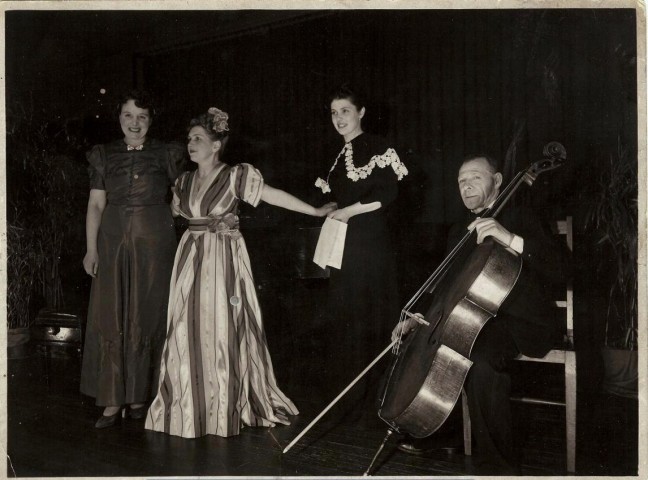
On 27th October 1948 Bernard Heinze, Ormond Professor at the Conservatorium of Music, University of Melbourne, wrote a letter to W.G. James, Director of Music at the ABC: “Mr. David Sisserman has called on me to know whether I would approach you with a view to his giving a recital in Sydney under the Commission’s direction. He has been doing a good deal of work in Melbourne, with some success. I myself heard him play recently, and see no reason why a recital should not be successful. Anything you can do in the matter would be warmly appreciated.” On 3rd November 1948 W.G. James replied that it would not be possible for the ABC to sponsor such a recital in Sydney; he mentioned that the Commission had already planned a heavy season and also that there was “practically no public interest” in cello recitals.
On November 28th 1948 David sent a telegram to his sister Sonya in New York: “AWAIT CONTRACT IN LONDON SAILING STRATHAIRD DECEMBER FIFTEENTH SHIPSCARD AMERICA SEND CURNARD FOR JANUARY LOVE ANTICIPATION DAVID.” So he was booked to travel to London on the Strathaird on 15th December 1948, and appears to be asking Sonya to then help with his fare to New York in January 1949.
England from 1949
On the boat to London.
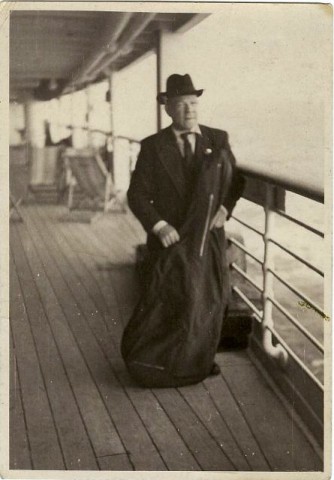
This picture was sent to his sister Sonia and her husband, with the inscription: “To my dearest Sister Sonia and my dear brother-in-law Misha from their devoted and grateful brother David, with love and gratitude. March 10th 1949, London.”
On arrival in London, it seems that Sisserman was not able to stay with his wife Raissa, his son George, or his brother Michael Zacharewitsch. It appears that he moved between a succession of rented rooms, including 87 Lansdown Road, W11, and 25 Holland Villas Road, W14.
On 2nd March 1949 he gave an “Informal Musical Evening” together with Adela Hamaton, the pianist with whom he had collaborated in the 1920s, and Zacharewitsch. The first item on the programme was “Description of activities by Professor David Sisserman during the last year of his visit to Australia.” The programme consisted of cello solos by Caix de Hervelois (Suite), Bach (Adagio from Toccata and Fugue in C Major for Organ), Kreisler (La Gitana), and Glazounow (Chant du Menestrel) and also Linda Philips: Jewish Love Song (the duet dedicated to him in 1937, here arranged as a solo). With Adela Hamaton, piano, he played Beethoven’s Sonata for Cello and Piano Op.5 No.1. With Zacharewitsch (violin) and Adela Hamaton (piano) he played Mozart’s Trio No.2 in B Flat.
Another recital with Adela Hamaton and Michael Zacharewitsch took place on 11th April 1949 at the London Musical Club, 21 Holland Park, Kensington W11.
On 8th April Sisserman sent another telegram to Sonya in New York: “SHIPS MENTIONED NOT CIRCULATING BOOKING APRIL SIXTEENTH IMMEDIATELY TRANSFER SEVENTY POUNDS 87 LANSDOWN ROAD WEST ELEVEN LETTER FOLLOWS. DAVID.”
However Sisserman remained in London. On 19th May 1949 a letter was sent to him (at 25 Holland Villas Road, London W14) from The Board of Guardians and Trustees for the Relief of the Jewish Poor: “I enclose herewith letter addressed to you by Sir Malcolm Sargent dated the 1st February, 1949, which was shown to the Committee who gave careful consideration to your application. I regret that the Board cannot help you on this occasion and it is considered that the members of your family should undertake this responsibility.”
By May 1949 Sisserman applied to emigrate to Canada, but on 2nd June the Canadian Immigration Service in London wrote: “I regret to inform you that you are unable to comply with the medical requirements for entry to Canada and I am, therefore, unable to endorse your medical card. In view of the above you should take no steps to proceed to Canada either for permanent residence or as a visitor”. On 8th June 1949 Sisserman wrote to his sister Sonya, in Russian, enclosing letters regarding his failed application to Canada.
On 25th June 1949 my father, George Seymour, wrote to Sonya from his office in London (48 Conduit Street, Regent Street, London W1): “My dear Aunt Sonia, By now you will doubtless have received back the remaining balance of the funds you sent out. The bank manager telephoned me as soon as father had been in to arrange for its return, and I was very glad that he had done the right thing. The trouble is that he has days of brain storm, and on such days does not act reasonably. Fortunately, your letter reached him opportunely, and so the main worry is disposed of. I am quite sure that he has every intention of repaying the few pounds that he had drawn on, but at the moment he is not covering his own living expenses and we all have to help with a few pounds here and there. How it will all end, I don’t know. I am returning the check as you ask …… Mother joins in sending her best wishes ….” And then added a hand-written note: “Since writing this have received your further letter for which many thanks. It is very generous of you to make monthly allowances to Father. I should advise you to send to the credit of an account with a Bank ….. as he tends to change his addresses frequently and without much warning. His present address is about the 6th since February, and he is talking of moving again!”
On 12th July 1949 Sisserman gave another recital at the London Musical Club, 21 Holland Park, Kensington W11. The programme consisted of Poem No. 2 by Bach, Sonata No. 2 in E Minor by Brahms, Melancholia by Sibelius, Variations on a Theme of “Rococo” by Tshaikowsky, Concerto Romantic by Saens Sans, The Busy Bee by Schubert, and “Jewish Love Song, dedicated to Professor David Sisserman by Linda Philips”. He was accompanied at the piano by “Miss RAISA SEYMOUR”. Sisserman sent the concert programme to his sister Sonya, with a letter (in Russian): “… I have to use Raya as accompanist because no-one can give his time for free. But Raya has gone bad as an accompanist because she has played so much with unprofessional people for fun…. The reason for my silence is my very difficult life and quite unpleasant work, which my situation requires. I do not want to write to you about this work because it made you sad before. Overall, fate is against me and I have to survive very difficult days without sleep. Nevertheless I am fighting and am still physically in life, but the soul is destroyed …”
In a letter to Sonya (in Russian) written from Cane Hill Mental Hospital two years later (dated 22nd November 1951 but post-marked January 1952) he gave more details on his life in 1949-50. “In London it is quite complicated to live always as a tenant, because no-one can control the landlords and they can therefore increase weekly rents without providing any benefits. So my possibility of having a permanent address deteriorated, and my wife Raya paid no attention to my critical situation. Because I was having to move from one apartment to another, I could not get a good position in a good orchestra, or have a good agent take an interest in me. In short, Raya gave me no monthly help, and I had to earn my own money helping in a restaurant (washing dishes and so on) which was very difficult for me… The total of all my work was as helper in a restaurant …. and then I had my life in solitude until 5 o’clock the next day…. So I had to live my life with no help from Raya and my son.”
A document in the National Archives of Australia shows that in November 1949, when he was 63, Sisserman was “trying to return to Australia under the assisted passage scheme”; the official commented that “personally I can not see this happening”.
Sisserman sent the following photograph to his sister Sonya some years after it was taken. It is inscribed: “1949-50. London. Sonia - To my dearest friend-sister with evergrown love and blessings for your health and prosperity, from your brother David xxxxxxxxxxxxxxxx 22nd August 1953. P.S. This was taken in the Trafalgar Square, while I was homeless and stayed at the Salvation Army Hostel but looking for employment.”
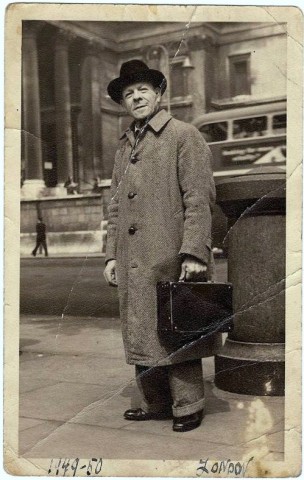
Nora gave this account: “And when we were living in Rodney Court … well I think he came back because he was ill – and he wanted to be with his family! Well I don’t know what he was ill with … but he was just unable to work. And it was terribly sad … I was terribly, terribly upset about it, because he had to sleep – he went to a doss house. I’d never known anyone before who slept in a doss house. But it was very sad …..”
An entry in “The Strad” magazine (vol. 61, p84) notes that in June/July 1950 “David Sisserman … gave two ‘cello recitals at the Abbey Community Centre. At the first of these the programme included his arrangement of Beethoven’s Sonata, Op. 30, No. 2 in C minor.” This is the Violin Sonata known as the “Eroica”, recently described as “formidable and thrilling“ and one of Beethoven’s “most iconic sonatas for piano and violin”.
At Cane Hill 1950-1952
On 14th October 1950 David Sisserman was admitted to the Cane Hill Mental Hospital in Coulsdon, Surrey, probably as a voluntary patient, He lived there for only 18 months, leaving in April 1952. Cane Hill opened as a Lunatic Asylum in 1883. Famously, Charlie Chaplin’s mother was admitted to Cane Hill in 1898 and was finally removed only in 1921, seven years before her death (Stephen Weissman, “Chaplin: A Life”, JR Books, 2009). In the 1950s Cane Hill had about 2400 patients (link).
Pam Buttrey’s book “Cane Hill Hospital: The Tower on the Hill” (Aubrey Warsash Publishing, 2010), drawing on official reports about the institution, paints a more positive picture than conventional stereotypes about such places. In 1951 “The Commissioners were impressed by the nurses’ very good care ….. with patients expressing appreciation of their kindness and thoughtfulness” (p. 202). And in January 1952 “the Commissioners described Cane Hill as ‘an old Hospital, and it suffers from years of past neglect ..’” But they thought “the OT [Occupational Therapy] centres excellent, and other departments concerned with the patients’ rehabilitation and resocialisation were exceptionally good” (pp. 207-208). Regular evening entertainments had started as early as the 1890s, and by 1945 “recreational activities included the cinema and dances for patients twice a week, at least four nursing staff having music qualifications” (p. 195). Then in 1949 a Dr Mitchell joined the staff; “known for his pioneering work in music therapy” he actively supported the new patients’ social club, whose activities included music appreciation. Dr Mitchell was described in a 1951 report as “ ‘popular and deeply appreciated’” (p. 202). Now “there was something every evening, often with doctors and senior staff involved. In March 1951 ….the patients put together an ‘Impromptu Concert’, with a pianist and soloists, tap dancing and a compere…. In April [1951], in the Gramophone Club …. Dr Mitchell talked about Haydn and Mozart. Having come recently, he started the patients’ orchestra which gave their first performance ….. Any patient could join….. Miss Anna Pollack and Mr Howard Allport from the Sadlers Wells Operatic Company gave a concert as did a professional celloist” (p. 215).
It was presumably Sisserman who gave the cello recital at Cane Hill. This sketch (which I was given by Raichka) is inscribed: “By W. Glazier. In admiration for your generous and most wounderful [sic] execution [sic] at the concert on the 14th of April 1951. Grateful yours. W. Glazier”.
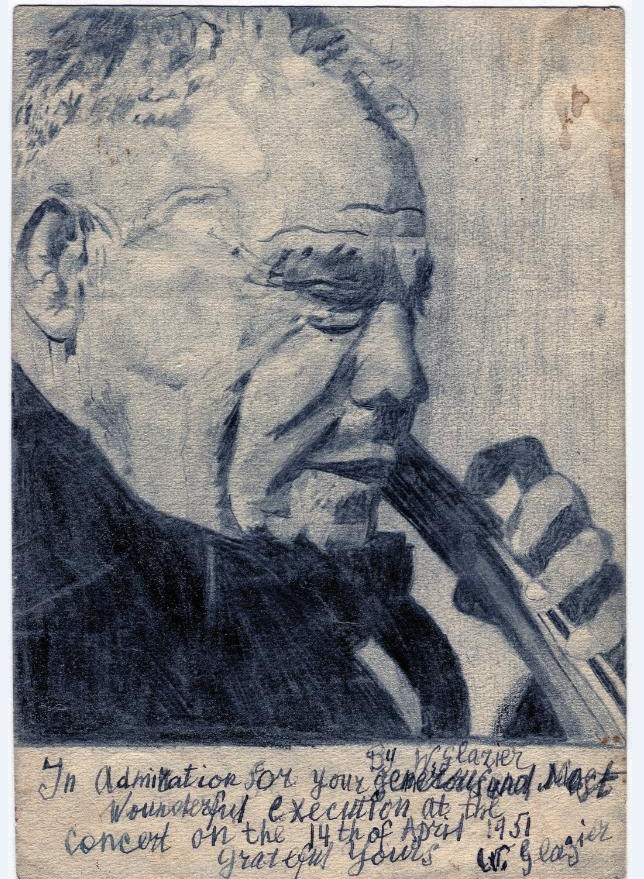
Dr Sydney Mitchell
(Many thanks to Elizabeth Bryant for much of this information about Sydney Mitchell.)
Dr Sydney David Mitchell was born in 1902. He adopted the surname of his mother, Amelia Mitchell, born 1877 in Sydney, Australia. His father Josiah Isaacs (1864-1948) was the Jewish owner of Isaacs & Co in Birmingham. Josiah Isaacs’ sister Esther (1860-1940) married Isaac Jacob Abrahams (born 1850 in Polish Lithuania) and their three sons were first cousins of Sydney Mitchell. They were Harold Abrahams (1899-1978) of ‘Chariots of Fire’ fame; the founder of sports science Sir Adolphe Abrahams (1883-1967); and Sir Sidney Solomon Abrahams (1885-1957), British Olympic athlete, lawyer, and Chief Justice of Ceylon (Sri Lanka).
David Sisserman left Cane Hill in April 1952. On 8 December 1953 Dr Mitchell died suddenly in the grounds of the hospital. He was aged 51. As a music therapist Dr Sydney Michell had worked closely with his wife Nora Gruhn, an opera singer born in Hampstead in 1905, the daughter of Hermann Grünbaum (born in Germany in 1872). Nora Gruhn died in St Albans in 2002, aged 97.
Final years 1951-1958
Sisserman wrote to Sonya from Cane Hill in November 1951: “Do not be surprised by my sudden letters, because at the moment I have the idea of planning a trip to New York…. My condition in these two years has given me new health, and my piano playing has improved and makes more progress in comparison to two years ago, when I tried to plan the trip.”
Sisserman left Cane Hill on 28th April 1952. By then Raichka had moved to the USA and re-married; my parents, my brother and I had moved to a new house in London NW9. Sisserman was apparently making financial claims, possibly through a lawyer, for property in the flat in Rodney Court, Maida Vale, where Raichka had lived since 1942 and where we had lived from 1948-1949. George wrote a letter on 26th November 1952: “Dear Sirs, I am obliged to you for your letter and for giving me my father’s present address, as I had only heard from him once since he left Cane Hill Mental Hospital.” George asserted that Sisserman had no claims on property at Rodney Court, and added: “He ceased to send anything towards her support about 1938.” Sisserman forwarded a copy of George’s letter to his sister Sonya, commenting on his difficult circumstances, and complaining of his treatment by Raichka. He ended: “Sorry to sadden you, but it is my only relief in my present lonely life. Blessings and good luck. Write soon. David xxxxx”.
George wrote to David Sisserman on 1st August 1953, regarding the matter of repairs to his cello. The repair costs would have to be “paid within a short time. I am afraid that it would not be possible for me to find such a sum of money, although if you could raise the greater part of it I might, in a few months time be able to help you with £3 or £4 ….. I do not know when I may be able to bring the family down to Chichester to see you, but hope we shall be able to manage it soon after our return” from summer holidays. “It was nice to have seen you again and looking well ….. Your son, George.”
Sisserman was living not in the town of Chichester (West Sussex) but a few miles away at Woodcroft, West Walberton Lane, Walberton, where he would remain until his death in 1958. I do not know how Sisserman came to live at Woodcroft, but there are two possibilities. One is that as Walberton is 23 miles from Haslemere, where his nephew Joseph Saxby lived, he went from Cane Hill to Walberton via Haslemere.
The second possibility is this. In 1951, the year before Sisserman left Cane Hill, Nora’s sister Ruth had married Ted Fischeles who was also of Russian origin (born in Odessa in 1909). Ted had trained for the RAF at the Yapton Aero Club, which is only 3 miles from Walberton, so it seems likely that Ted made the contact for his fellow Russian.
When we made our only family visit to David Sisserman, in 1953, he was living not in the house but in a caravan in the grounds of Woodcroft. Nora gave this account of the visit: “George took me down and the boys, and we went down - it must have been on a Sunday, and … he sat outside the caravan – and I can see it – with his cello and he played to us. It’s very touching….“
A year after our visit, in October 1954 when Sisserman was 68, he made a final enquiry about returning to Australia. A document in the National Archives of Australia records: “We have received a letter from ‘Professor David Sisserman’ enquiring whether we could arrange for him to go back to Australia as ‘leading cellist and solo broadcast performer’. We pass this on merely for your information.”
David Sisserman’s name (spelt Zisserman) appears in electoral registers for Walberton district from February 1955 to February 1958. His address does not (unlike entries for contemporary addresses) include a reference to a caravan, so it is possible that he moved into the house, whose other resident was then James William Wilds. Mr Wilds was exactly the same age as Sisserman; born in Westhampnett, a village just outside Chichester, in 1886, he appears in Navy records for 1903 and lived at Woodcroft until his death in 1979 aged 93.
Death
David Sisserman died at Woodcroft on the 28th November 1958, aged 72. His death certificate records: “Postmortem without inquest. Causes of death: a) Mitral stenosis [valvular heart disease characterized by the narrowing of the orifice of the mitral valve of the heart] b) Rheumatic disease of heart.”
He was buried in Bognor Regis, a nearby town on the Sussex coast. George and Raichka drove down from London for the funeral. They did not take myself or my brother David, and Nora had only three months before given birth to Jeffrey.
I visited David Sisserman’s grave on 12th March 2015
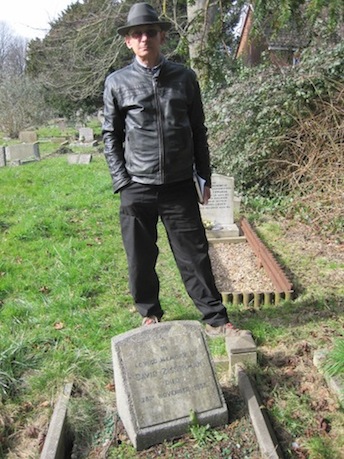
See also Tony Seymour, “David Sisserman (1886-1958), Cellist: In Australia 1929-30 and 1933-48”, Australian Jewish Historical Society Journal, November 2014, Vol.XXII, Part 1, pp.47-90.
Page last updated 28 Nov 2025.
